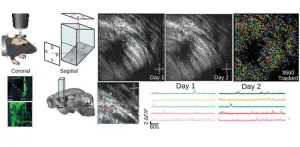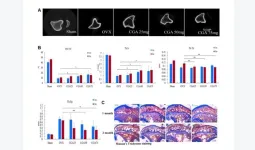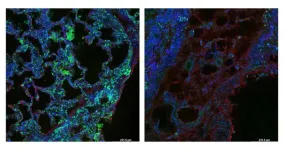(Press-News.org) PHILADELPHIA – Patients being treated for B-cell non-Hodgkin’s Lymphoma (NHL) who are part of minority populations may not have equal access to cutting-edge CAR T cell therapies, according to a new analysis led by researchers from the Perelman School of Medicine at the University of Pennsylvania and published today in NEJM Evidence.
CAR T cell therapy is a personalized form of cancer therapy that was pioneered at Penn Medicine and has brought hope to thousands of patients who had otherwise run out of treatment options. Six different CAR T cell therapies have been approved since 2017 for a variety of blood cancers, including B-cell NHL that has relapsed or stopped responding to treatment.
“CAR T cell therapy represents a major leap forward for blood cancer treatment, with many patients living longer than ever before, but its true promise can only be realized if every patient in need has access to these therapies,” said lead author Guido Ghilardi, MD, a postdoctoral fellow in the laboratory of senior author Marco Ruella, MD, an assistant professor of Hematology-Oncology and Scientific Director of the Lymphoma Program. “From the scientific perspective, we’re constantly working in the laboratory to make CAR T cell therapy work better, but we also want to make sure that when a groundbreaking treatment like this becomes available, it reaches all patients who might be able to benefit.”
Reducing cancer disparities—differences in incidence, diagnosis, screening, treatment, and outcomes—is a major focus in oncology, with many groups working to understand and address the disparities that patients from certain racial/ethnic and/or socioeconomic backgrounds experience. For example, Black and African American patients have higher death rates than other racial/ethnic groups for many cancer types, including large B-cell lymphoma (LBCL), the most common subtype of NHL.
This study assessed the percentage of patients from minority health populations—defined by the federal government as those who identify as American Indian or Alaskan Native, Asian, Black or African American, and Native Hawaiian or other Pacific Islander—treated for LBCL and the percentage who received CAR T cell therapy at two different cancer centers between 2018 and 2022. The researchers included data from Penn Medicine’s Abramson Cancer Center (ACC) in Philadelphia, where the minority health population prevalence is higher than the United States average, and from the Oregon Health and Science University’s Knight Cancer Institute (KCI) in Portland, which has a lower minority population than the U.S. average. The percentage of minorities with NHL in each center’s catchment area (the surrounding countries that make up the primary population served by a health system) mirrored the percentages treated at each center, indicating equitable access to cancer care for the local community in both locations.
However, treatment with CAR T cell therapy was limited for these patients: at the ACC, minority populations accounted for 15.7 percent of LBCL patients treated, but only 6.7 percent of LBCL patients who received CAR T cell therapy. At the KCI, minorities accounted for 6.6 percent of LBCL patients treated, but only 4.2 percent of LBCL patients who received CAR T cell therapy.
While the retrospective study was not designed to determine the cause of these inequities, the researchers theorize that contributing factors could range from clinical barriers (such as other medical conditions) to provider barriers (such as unconscious bias), and/or socioeconomic barriers (such as financial or insurance challenges).
“With any health disparity, gathering evidence and raising awareness is an important first step, but our work on this issue isn’t done,” Ruella said. “I hope this study prompts the oncology community to think critically about how we can work together to understand and overcome potential treatment barriers so that every patient can receive the best possible therapy for their specific situation and cancer type.”
To further the research, Ruella’s team is collaborating with Carmen Guerra, MD, the Ruth C. and Raymond G. Perelman Professor of Medicine and associate director of Diversity and Outreach for the ACC, and Jalpa Doshi, PhD, a professor of Medicine and senior fellow at the Leonard Davis Institute of Health Economics, to learn more about the key factors and challenges that might limit minority patients’ access to CAR T cell therapy.
This work was supported by the Laffey-McHugh Foundation, the Berman and Maguire Funds for Lymphoma Research at Penn, the Society for Immunotherapy of Cancer, the Mario Luvini Fellowship grant, and the National Cancer Institute (P01 PCA214278C and the R01/37-CA262362-01A1).
###
Penn Medicine is one of the world’s leading academic medical centers, dedicated to the related missions of medical education, biomedical research, excellence in patient care, and community service. The organization consists of the University of Pennsylvania Health System and Penn’s Raymond and Ruth Perelman School of Medicine, founded in 1765 as the nation’s first medical school.
The Perelman School of Medicine is consistently among the nation's top recipients of funding from the National Institutes of Health, with $550 million awarded in the 2022 fiscal year. Home to a proud history of “firsts” in medicine, Penn Medicine teams have pioneered discoveries and innovations that have shaped modern medicine, including recent breakthroughs such as CAR T cell therapy for cancer and the mRNA technology used in COVID-19 vaccines.
The University of Pennsylvania Health System’s patient care facilities stretch from the Susquehanna River in Pennsylvania to the New Jersey shore. These include the Hospital of the University of Pennsylvania, Penn Presbyterian Medical Center, Chester County Hospital, Lancaster General Health, Penn Medicine Princeton Health, and Pennsylvania Hospital—the nation’s first hospital, founded in 1751. Additional facilities and enterprises include Good Shepherd Penn Partners, Penn Medicine at Home, Lancaster Behavioral Health Hospital, and Princeton House Behavioral Health, among others.
Penn Medicine is an $11.1 billion enterprise powered by more than 49,000 talented faculty and staff.
END
The beautiful, gnarled, nooked-and-crannied reefs that surround tropical islands serve as a marine refuge and natural buffer against stormy seas. But as the effects of climate change bleach and break down coral reefs around the world, and extreme weather events become more common, coastal communities are left increasingly vulnerable to frequent flooding and erosion.
An MIT team is now hoping to fortify coastlines with “architected” reefs — sustainable, offshore structures engineered to mimic the wave-buffering effects of natural reefs while also providing pockets for fish and other marine ...
University of Maryland School of Medicine (UMSOM) Dean Mark T. Gladwin, MD, announced today that Martine Rothblatt PhD, JD, MBA, Chairperson and CEO of United Therapeutics, and inventor of SiriusXM Satellite Radio, will deliver the keynote address for this year’s graduating medical student class. The UMSOM MD graduation ceremony will take place at the Hippodrome Theatre on Thursday, May 16, 2024. The ceremony will begin at 1:00 pm. Details for faculty members are here. Details for students/guests are here.
Dr. Rothblatt is a trailblazing pioneer of several innovations in biotechnology, pharmaceuticals, and satellite communications. After developing SiriusXM, ...
The ORIGAMI (Optimized Resource Integration and Global Architecture for Mobile Infrastructure for 6G) project is now underway. The project, funded by the European Commission under the Horizon Europe program, will spearhead architectural innovations for the next generation of 6G mobile networks, to enable innovative applications, new business models, and substantial reductions in energy consumption.
By proposing and developing three critical architecture innovations – Global Services Based Architecture (GSBA), Zero Trust Exposure Layer (ZTL), and Continuous Compute ...
New research says the wide variety of skills displayed by people with conditions such as ADHD, dyslexia and autism should be celebrated to help reduce stigma and change society’s expectations.
Creativity, resilience and problem-solving are just some of the strengths exhibited and a study is now calling for a change in the way we think about people with neurodevelopmental conditions.
Dr Edwin Burns, senior lecturer from the School of Psychology at Swansea University, worked with academics from Edge Hill University on the study and their findings have just been published by ...
Local and state governments have a variety of tools at their disposal to attract businesses or entice them to stay. One is tax relief. Austin, for example, helped lure electric automaker Tesla in part with property tax rebates worth $14 million over 10 years.
In a study released today from Texas McCombs, Dean and Accounting Professor Lillian Mills finds that another kind of government aid — cash grants — has a different kind of impact. It helps companies lighten their balance sheets by borrowing less.
Corporations ...
TUCSON, Ariz., March 26, 2024 — Critical Path Institute (C-Path) is excited to announce the launch of the Critical Path for Alpha-1 Antitrypsin Deficiency (CPA-1) Consortium. The CPA-1 consortium aims to accelerate drug development for alpha-1 antitrypsin deficiency (AATD), a rare disease that affects individuals and families worldwide. This will be achieved by integrating data through C-Path’s Rare Diseases Cures Accelerator–Data Analytics Platform (RDCA-DAP®) and leveraging those data for CPA-1 to collaboratively develop regulatory-grade solutions to continuously address unmet needs in drug development for this condition, including:
Generating evidence to ...
COLUMBUS, Ohio – When the skeletal remains of a giant ground sloth were first unearthed in 1796, the discovery marked one of the earliest paleontological finds in American history.
The animal, named Megalonyx by Thomas Jefferson in 1799, was the first genus of fossil named from the United States. Thought to have roamed North America during one of the last ice ages, the extinct giant ground sloth was an herbivorous mammal resembling a large bear — at full size, it likely reached nearly 10 feet tall (3 meters) and weighed about as much as a small elephant.
The report made by Jefferson, an avid fossil collector who was known to keep ...
Organisms constantly face the challenge of adapting their behavior to survive in a world full of uncertainties. This ability relies on complex neural circuits in the brain that help them find resources while avoiding danger. Scientists study how these neural circuits change over time to understand better how behaviors emerge.
One powerful way to study these changes is through optical imaging techniques that allow researchers to track the activity of individual brain cells. Traditional methods rely on observing the activity of cells directly, ...
“[...] chlorogenic acid appears to be a promising candidate for the management of osteoporosis.”
BUFFALO, NY- March 26, 2024 – A new research paper was published in Aging (listed by MEDLINE/PubMed as "Aging (Albany NY)" and "Aging-US" by Web of Science) Volume 16, Issue 5, entitled, “Chlorogenic acid prevents ovariectomized-induced bone loss by facilitating osteoblast functions and suppressing osteoclast formation.”
Osteoporosis is a common bone disease in ...
Researchers at Weill Cornell Medicine have discovered a protein called SEL1L that plays a critical role in clearing collagen from tissue, and which may be a therapeutic target to help prevent fibrosis, scar tissue that interferes with organ function. The paper, published on Feb. 20 in Nature Communications, provides clues that could lead to drug development for diseases like lung fibrosis which have no therapeutic options currently.
Corresponding author, Dr. Michael J. Podolsky, assistant professor of medicine at Weill Cornell Medicine, has led a team that searched the human genome for genes involved in the ...




